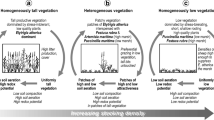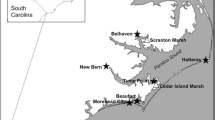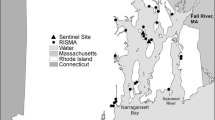Abstract
The ecological importance of Plantago maritima within a salt marsh on the Bay of Fundy is documented through measurements of cover, density, and biomass. During late August 1993, peak standing crops of Plantago were as high as 532 g m−2, and composed as much as 96% of the biomass of a stand of vegetation. Plantago is a dominant component of the marsh vegetation at an elevation just above the Spartina alterniflora-dominated low marsh, and is found as a dominant when growing in association with a number of plant species characteristic of the high marsh. We hypothesize that the existence of this community is dependent upon regular ice-shearing of Spartina patens, which would otherwise competitively exclude Plantago. This hypothesis is supported by the elevational limits of Plantago dominance and the geographical limitation of Plantago communities to portions of the northwestern Atlantic subjected to winter temperatures which average below 0°C.
Similar content being viewed by others
Literature Cited
Bakker, J. P. and Y. de Vries. 1992. Germination and early establishment of lower salt-marsh species in grazed and mown salt marsh. Journal of Vegetation Science 3:247–252.
Bertness, M. D. and A. M. Ellison. 1987. Determinants of pattern in a New England salt marsh plant community. Ecological Monographs 57:129–147.
Campbell, I. D. and J. H. McAndrews. 1991. Cluster analysis of late Holocene pollen trends in Ontario. Canadian Journal of Botany 69:1719–1730.
Canadian Hydrographic Service. 1995. Canadian Tide and Current Tables, Vol. 1: Atlantic Coast and Bay of Fundy. Ottawa, Ontario, Canada.
Cermack, V. 1971. Underground temperature and inferred climatic temperature of the past millennium. Palaeogeography, Palaeoclimatology, Palaeocology 10:1–19.
Connor, R. F. and G. L. Chmura. in press. Patterns of below ground productivity in a Fundy saltmarsh. Marine Ecology Progress Series.
Daoust, R. J., T. R. Moore, G. L. Chmura, and J. F. Magenheimer. 1996. Chemical evidence of environmental changes and anthropogenic influences in a Bay of Fundy saltmarsh. Journal of Coastal Research 12:420–433.
Dionne, J. C. 1989. The role of ice and frost in tidal marsh development—A review with particular reference to Québec, Canada. Essener Geogr. Arbeiten 18:171–210.
Environment Canada. 1990. The Climates of Canada. Canadian Government Publishing Centre Supply and Services Canada, Ottawa.
Ganong, W. F. 1903. The vegetation of the Bay of Fundy salt and dyked marshes: An ecological study. Botanical Gazette 36: 161–186, 280–302, 349–367, 429–455.
Gleason, H. A. and A. Cronquist. 1991. Manual of Vascular Plants of Northeastern United States and Adjacent Canada. The New York Botanical Garden, New York.
Gordon, D. C., Jr., and D. Desplanque. 1983. Dynamics and environmental effects of ice in the Cumberland Basin of the Bay of Fundy. Canadian Journal of Fisheries and Aquatic Sciences 40:1331–1342.
Gordon, D. C., Jr., P. J. Cranford, and C. Desplanque. 1985. Observations on the ecological importance of salt marshes in the Cumberland Basin, a macrotidal estuary in the Bay of Fundy. Estuarine, Coastal and Shelf Science 20:205–227.
Grove, J. M. 1988. The Little Ice Age. Methuen, New York.
Jacobson, H. A. and G. L. Jacobson, Jr. 1989. Variability of vegetation in tidal marshes of Maine, U.S.A. Canadian Journal Botany 67:230–238.
Jacobson, G., L., Jr. and H. A. Jacobson. 1989. An inventory of distribution and variation in salt marshes from different settings along the Maine coast, p. 69–83. In W. A. Anderson, and H. W. Borns, Jr. (eds.), Neotectonics of Maine. Maine Geological Survey Bulletin 40.
Jerling, L. 1985. Population dynamics of Plantago maritima along a distributional gradient on a Baltic seashore meadow. Vegetatio 61:155–161.
Ladurie, E. L. R. 1971. Times of Feast, Times of Famine: A History of Climate Science the Year 1000. Translated by Barbara Bray. Doubleday, Garden City, New York.
Létourneau, G. 1996. Répertoire des activités de télédétection au Center Saint-Laurent—Module: Marais, marécages et herbiers le long du Saint-Laurent. Environment Canada, Direction de la conservation, Région du Québec, Centre Saint-Laurent. Scale 1:20,000.
Magenheimer, J. E., T. R. Moore, G. L. Chmura, and R. Daoust. 1996. Methane and carbon dioxide flux from a macrotidal salt marsh, Bay of Fundy, New Brunswick. Estuaries 19:139–145.
Miller, W. R. and F. E. Egler. 1950. Vegetation of the Wequetequock-Pawcatuck tidal marshes, Connecticut. Ecological Monographs 20:143–172.
Mueller-Dombois, D. and H. Ellenberg. 1974. Aims and Methods of Vegetation Ecology. John Wiley & Sons, New York.
National Oceanic and Atmospheric Administration. 1983. Climate Normals for the U.S. (Base: 1951–1980) first edition. Gale Research Company, Detroit, Michigan.
Nixon, S. W. 1982. The ecology of New England high salt marshes: A community profile. United States Fish and Wildlife Service OBS-81/85.
Pielou, E. C. and R. D. Routledge. 1976. Salt marsh vegetation: Latitudinal gradients in the zonation patterns. Oecologia (Berlin) 24:311–321.
Redfield, A. C. 1972. Development of a New England salt marsh. Ecological Monographs 42:201–237.
Reed, A. and G. Moisan 1971. The Spartina tidal marshes of the St. Lawrence Estuary and their importance to aquatic birds. Naturaliste Canadienne 98:905–922.
Teal, J. M. 1986. The ecology of regularly flooded salt marshes of New England: A community profile. United States Fish and Wildlife Service Biological Report 85(7.4).
Thannheiser, D. 1984. The coastal vegetation of eastern Canada. Memorial University of Newfoundland Occasional Papers in Biology No. 8. St. John’s, Newfoundland.
Thomas, M. L. H. 1983. Salt marsh systems, p. 107–118. In M. L. H. Thomas (ed.), Marine and Coastal Systems of the Quoddy Region, New Brunswick. Canadian Special Publication of Fisheries and Aquatic Sciences No. 64, Fisheries and Oceans Canada.
Van Zoost, J. R. 1970. The ecology and waterflow utilization of the John Lusby National Wildlife Area. M.Sc. thesis, Acadia University. Wolfville, Nova Scotia.
Author information
Authors and Affiliations
Corresponding author
Rights and permissions
About this article
Cite this article
Chmura, G.L., Chase, P. & Bercovitch, J. Climatic controls of the middle marsh zone in the Bay of Fundy. Estuaries 20, 689–699 (1997). https://doi.org/10.2307/1352244
Received:
Accepted:
Issue Date:
DOI: https://doi.org/10.2307/1352244




